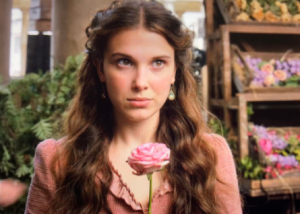Things Haven’t Always Been the Same
Idols such as Kim Kardashian influence the beauty standards we know of today.
December 21, 2022
If you think of a princess from long ago, whether it’s something from Disney or Netflix, it’s likely that a beautiful woman in jewels might appear in your mind.
However, your definition of beauty might not match how a princess actually looked. Was she stick-thin like Elsa or Mulan or even Princess Leia? Probably not.
From the 1400s to the 1900s, it was ideal for a woman to be a bit more full-figured. According to Science of the People, “During the Italian Renaissance, it was the wife’s duty to reflect her husband’s status, both in behavior and outward appearance.” This means that as a sign of wealth and health, a woman was considered most attractive if she was plump, showing that she had “the dough” to pay for her food (pardon the pun).
A collaborative project through the University of Delaware details the fear of death through pregnancy: “Women typically gave birth to eight to ten children; however, due to high mortality rates, only raised five or six children.”
In response, culture presumed that larger women meant a higher chance of survival in an era where it was normal to lose 3-4 children.
In our generation, a person who weighs more might be deemed unworthy by others. Instead of the acceptance of having different body types, our society has created the belief that she has to be slim, have clear skin, and maintain an hourglass figure.
“From medieval times, I guess it makes sense because it was a symbol of status, but nowadays it’s not really the same. Your appearance is just what you think of yourself,” said 8th grader Angeline Zhu.
Every generation has created its own standard of beauty. These standards weren’t created overnight. Celebrities play a key role in how people see themselves.
From former monarchs like Queen Victoria, classic movie stars like Marilyn Monroe, and modern reality TV star Kim Kardashian, media “idols” all influence the expectation of how we should look.
Pulse reports that “many people think celebrities and influencers are aspirational. They want to look like them because of how stunning they look and dress. This means they have a lot of influence, set trends and change beauty perceptions.”
Social media platforms like Instagram, TikTok, Facebook, and Twitter each compound the problem by featuring people who also post unrealistic pictures of themselves. Teens feel the urge to use filters to show their best side, which paints a fake portrait of what they authentically look like and raises false expectations among their peers.
“Social media images are filled with people presenting the best version of themselves. Social media can then hurt your body image by constantly exposing yourself to the ideal body type, leading to constant comparison of yourself to unrealistic standards. Additionally, photoshop and filters are readily available to users playing into the unrealistic body image,” says Illinois State University.
Beauty standards aren’t new. Though prior generations didn’t have phones and computers, they still experienced televisions, newspapers, and social gatherings, which set trends of that era. For example, Marilyn Monroe spread fashion influence throughout her iconic movie roles.
According to Youthvoices.live, “Acting in these iconic films would produce Marilyn Monroe’s signature makeup look, which would, without a doubt, have an influence on women’s beauty standards.”
For the critics out there who object to judging by looks, can’t we all admit that we’re part of the problem? Who hasn’t made a decision based on someone else’s appearance?
“It’s a survival instinct to quickly assess a person to determine if they are a threat. Things such as how they dress or their initial behavior help you to make a quick judgment upon meeting a person.” says lifehack.
While it may be natural to decide if a person is trustworthy based upon their appearance, that doesn’t make it healthy. The more you compare yourself to the people on social media and those around you, the more your mental and physical health is affected.
According to River’s Edge,“The more you judge others, the more you judge yourself. By constantly seeing the bad in others, we train our minds to find the bad. This can lead to an increase in stress. Stress can weaken the immune system and cause high blood pressure, fatigue, depression, anxiety and even stroke.”
Beauty standards have been with us for a long time and have come at tremendous cost to our culture. They’ve continuously evolved, despite their negative effects on society, particularly females.
“Who knows, maybe next year those insecurities you were told you have to have will change into beauty standards,” said Harlow M.






